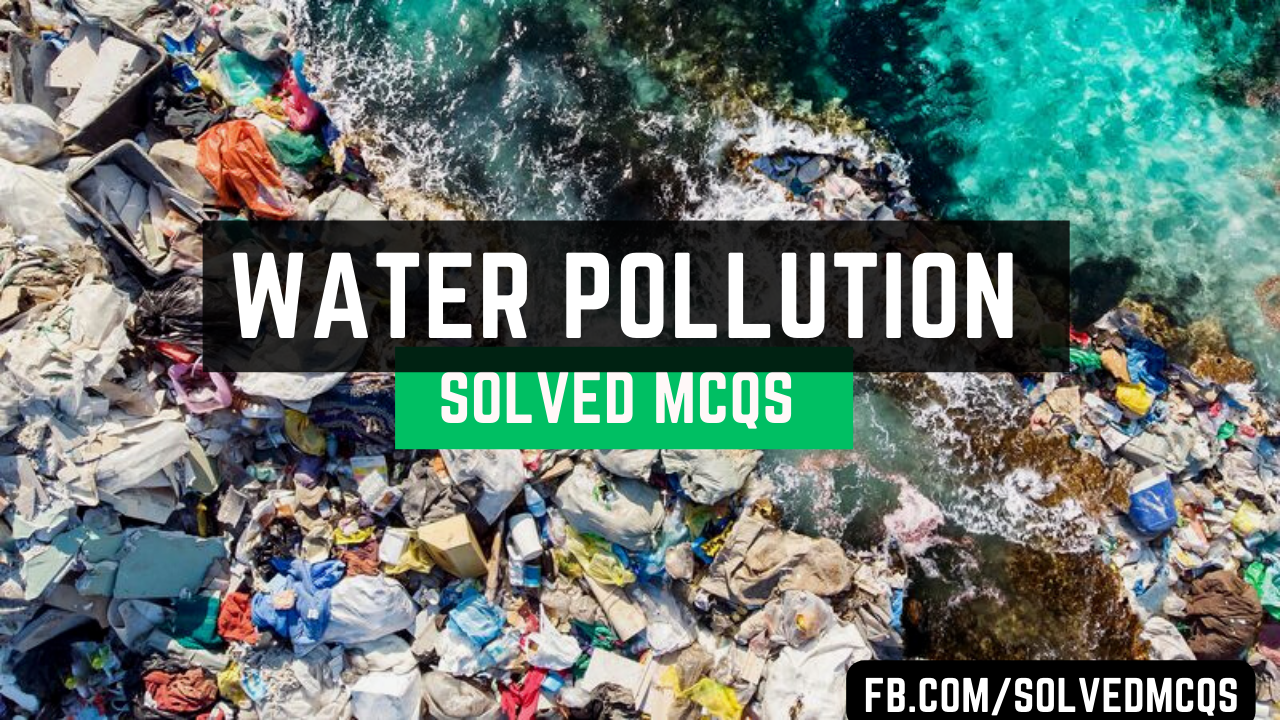Water Pollution Multiple Choice Questions MCQs with Answers 1. Which organisms are found in human waste that causes water pollut...
Water Pollution Multiple Choice Questions MCQs with Answers
1. Which organisms are found in human waste that causes water pollution?
a. Coliform bacteria
b. Viruses
c. Protozoa
d. Parasitic worms
Answer: a. Coliform bacteria
2. Which is the indicator of pollution in water?
a. Amount of oxygen
b. Amount of hydrogen
c. Amount of BOD
d. Amount of nitrogen
Answer: c. Amount of BOD
3. What is the reason that certain parts of water bodies contain more algae?
a. Due to favorable environment
b. Due to run-off excess fertilizers
c. Due to lack of fertilizers
d. Due to water pollution
Answer: b. Due to run-off excess fertilizers
4. What are water-soluble inorganic chemicals?
a. Compound of pure metals
b. Compound of non-metal
c. Compounds of synthetic metals
d. Compounds of toxic metals
Answer: d. Compounds of toxic metals
5. When does sediment of suspended matter occur?
a. When soil is eroded from air
b. When soil is eroded from land
c. When soil is eroded from water
d. When soil is eroded by rock
Answer: c. When soil is eroded from water
6. What is a sediment of suspended matter?
a. Insoluble particles of soil and other solids
b. Soluble particles of soil and other solids
c. Insoluble particles of water
d. Soluble particles of water
Answer: b. Soluble particles of soil and other solids
7. Where are water-soluble radioactive isotopes found?
a. In radioactive reactor
b. In radioactive coolant
c. In radioactive shield
d. In radioactive waste
Answer: d. In radioactive waste
8. Why the thermal pollution causes the release of hot water?
a. They increase the solubility of oxygen
b. They decrease the solubility of oxygen
c. They dissolve oxygen
d. They dissolve nitrogen
Answer: b. They decrease the solubility of oxygen
9. Hard water does not form lather because of the presence of:
a. Flouride ion
b. Calcium ion and magnesium ion
c. Sodium and potassium ion
d. Rocks
Answer: b. Calcium ion and magnesium ion
10. How many types of the hardness of water are there?
a. Two
b. Three
c. Four
d. Six
Answer: a. Two
11. What is the other name for the temporary hardness of water?
a. Constant hardness
b. Continuous hardness
c. Carbonate hardness
d. Affiliated hardness
Answer: c. Carbonate hardness
12. Which reagents are present in temporary hardness?
a. Bicarbonates
b. Carbonates
c. Chlorides
d. Sulfates
Answer: a. Bicarbonates
13. The permanent hardness is also known as:
a. Bicarbonate hardness
b. Non-carbonate hardness
c. Carbonate hardness
d. Constant hardness
Answer: b. Non-carbonate hardness
14. What is the permissible limit of pH preferred for potable water?
a. 7-8.5 ppm
b. 6.5-9ppm
c. 10-14ppm
d. 1-7ppm
Answer: b. 6.5-9ppm
15. What is the amount of oxygen required to oxidize organic matter in sewage?
a. Turbidity
b. Biological oxygen demand
c. Chemical oxygen demand
d. Chemical oxygen demand
Answer: b. Biological oxygen demand
16. Which of the following rivers is called the most polluted river in the world?
a. Citarum River, Indonesia
b. Yellow River, China
c. Ganga River, India
d. Ravi River, Pakistan
Answer: c. Ganga River, India
17. Which of the following are the main causes of water pollution?
a. Industrial Waste
b. Marine Dumping
c. Sewage and Wastewater
d. All of these
Answer: d. All of these
18. What of the following is the best method to reduce total dissolved solids (TDS) in the water?
a. Reverse Osmosis
b. Distillation
c. Ion exchange
d. All of these
Answer: a. Reverse Osmosis
19. Which of the following salt is the main cause of the permanent hardness of water?
a. Magnesium sulfate
b. Magnesium carbonate
c. Magnesium bicarbonate
d. All of these
Answer: a. Magnesium sulfate
20. A technique that is used to determine the concentration of odor compounds in the given water sample is…?
a. Flushing
b. Stripping
c. Chlorination
d. Settling
Answer: b. Stripping
21. Choose the correct example of waterborne disease:
a. Cholera
b. Typhoid
c. Polio
d. All of these
Answer: d. All of these
22. Arsenic gets into drinking water from…?
a. Industrial waste
b. Agricultural pollution
c. Natural rock formations
d. All of these
Answer: d. All of these
23. An algal bloom is mostly caused by the presence of…?
a. Carbon
b. Magnesium bicarbonate
c. Nitrogen and phosphorus present in water
d. Magnesium sulfate
Answer: c. Nitrogen and phosphorus present in water
24. Which of the following diseases or infections is caused due to contaminated water and poor sanitation?
a. Cholera
b. Typhoid
c. Hepatitis A
d. All of these
Answer: d. All of these
25. Choose the correct statement about the composition of Calcium Carbonate (CaCo3) in soft water?
a. 90 to 120 milligrams of CaCO3 per liter
b. 0 to 30 milligrams of CaCO3 per liter
c. 60 to 90 milligrams of CaCO3 per liter
d. 30 to 60 milligrams of CaCO3 per liter
Answer: d. 30 to 60 milligrams of CaCO3 per liter
26. Temporary hardness of water is caused by the presence of…?
a. Calcium sulfate
b. Magnesium sulfate
c. Magnesium carbonate
d. Magnesium chloride
Answer: c. Magnesium carbonate
27. The water having less than 1000 mg/liter of total dissolved solids is known as…?
a. Brine water
b. Slightly saline
c. Freshwater
d. Moderately saline
Answer: c. Freshwater
28. Which of the following units are used to measure the turbidity of water?
a. NTU – Nephelometric Turbidity Units
b. FNU – Formazin Nephelometric Unit
c. EAU – Formazin Attenuation Units
d. All of these
Answer: d. All of these
29. Which of the following is NOT a waterborne disease?
a. Asthma
b. Cholera
c. Typhoid
d. Hepatitis
Answer: a. Asthma








COMMENTS